Attracting hummingbirds to your garden is a delightful experience, and making your own hummingbird food is a simple and rewarding way to do it. This easy homemade hummingbird food recipe uses just two ingredients and is much healthier for these tiny birds than store-bought alternatives. Learn How To Make Hummingbird Food and enjoy the beauty of hummingbirds fluttering in your backyard all season long.
Why Homemade Hummingbird Food is Best
Store-bought hummingbird food often contains unnecessary dyes and preservatives that can be harmful to hummingbirds. Making your own hummingbird food ensures you are giving these delicate creatures a healthy and natural food source. Plus, it’s incredibly cost-effective and quick to prepare, using ingredients you likely already have in your pantry.
My family and I love watching hummingbirds in our garden. Their energetic flights and vibrant colors bring so much joy. Creating your own hummingbird food is a fantastic family activity, allowing everyone to participate in attracting these amazing birds. It’s a great way to connect with nature and learn more about these fascinating creatures.
Simple Hummingbird Food Recipe: Just Two Ingredients
The best hummingbird food recipe is also the simplest. You only need two ingredients:
- Water
- Granulated White Sugar
The ratio is key: 4 parts water to 1 part sugar. This mimics the natural nectar found in flowers, providing hummingbirds with the energy they need.
Step-by-Step Guide: Making Hummingbird Food
Making hummingbird food at home is incredibly easy. Follow these simple steps:
- Boil the Water: Bring the water to a boil in a saucepan. Boiling helps to purify the water and dissolve the sugar more effectively.
- Dissolve the Sugar: Remove the water from the heat and stir in the granulated white sugar until it is completely dissolved. Continue stirring until no sugar granules are visible at the bottom of the pan.
- Cool Completely: Allow the sugar water mixture to cool completely to room temperature before filling your hummingbird feeder. Never put warm or hot hummingbird food into a feeder as it can promote mold growth and deter birds.
Once your homemade hummingbird food is ready, fill your clean hummingbird feeder and hang it in your garden. Keep an eye on your feeder and get ready to welcome these beautiful birds to your yard!
Important Tips for Hummingbird Food
- No Red Dye: It’s crucial not to add red food coloring to your hummingbird food. Red dye is unnecessary and can be harmful to hummingbirds. Hummingbird feeders are typically red to attract birds, so the color of the food is irrelevant.
- Use White Granulated Sugar: Only use plain white granulated sugar. Avoid using honey, brown sugar, powdered sugar, artificial sweeteners, or any other type of sugar. These alternatives can be harmful or even fatal to hummingbirds. White sugar is the closest to natural flower nectar and is easily digestible for them.
- Regular Cleaning: Clean your hummingbird feeder every few days, especially in warm weather, to prevent mold and bacteria growth. Use hot water and a bottle brush to scrub all parts of the feeder. Rinse thoroughly before refilling.
- Fresh Food: Replace the hummingbird food every 1-2 days, even if it looks like it hasn’t been fully consumed. This ensures the food remains fresh and healthy for the birds.
- Storage: Store leftover hummingbird food in the refrigerator for up to two weeks. Discard any unused portion after this time or if you notice any cloudiness or mold.
Frequently Asked Questions about Hummingbird Food
Can I use tap water?
Yes, tap water is perfectly fine to use for hummingbird food. Boiling the water, as recommended in the recipe, will help remove any potential impurities and ensure the sugar dissolves properly.
Why boil the water?
Boiling the water is an important step because it helps to purify the water, removing any bacteria or mold spores that could contaminate the hummingbird food. It also helps the sugar dissolve completely, creating a consistent and appealing nectar for the birds.
What kind of sugar is best?
Granulated white sugar, also known as table sugar, is the best and safest type of sugar to use for hummingbird food. It most closely mimics the sucrose found in natural flower nectar. Avoid all other types of sugars, as they can be detrimental to hummingbird health.
How often should I change hummingbird food?
It’s best to change the hummingbird food every 1-2 days, especially in warm weather. This prevents fermentation and mold growth, which can be harmful to hummingbirds. Regularly changing the food ensures you are providing a fresh and healthy food source.
Attracting More Hummingbirds to Your Yard
Beyond providing homemade hummingbird food, there are other ways to attract these delightful birds to your yard:
- Plant Hummingbird-Friendly Flowers: Hummingbirds are naturally attracted to brightly colored, tubular flowers that produce nectar. Plant varieties like bee balm, salvia, petunias, and trumpet vine in your garden to create a natural food source and attract hummingbirds. Red and orange flowers are particularly appealing to them.
- Provide Water Sources: Hummingbirds also need water. A birdbath, shallow dish of water, or even a gentle sprinkler can provide them with a place to drink and bathe.
- Choose the Right Feeder: Select a hummingbird feeder that is easy to clean, durable, and has red parts to attract hummingbirds. Glass or sturdy plastic feeders are good choices.
- Feeder Placement: Place your hummingbird feeder in a partially shaded area, away from direct sunlight, which can cause the food to spoil quickly. Hang feeders near trees or shrubs to provide hummingbirds with a sense of security and perching spots.
By following these simple steps and tips, you can easily make your own hummingbird food and create a welcoming habitat for these amazing birds in your backyard. Enjoy the beauty and wonder they bring to your outdoor space!


